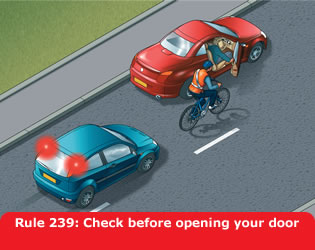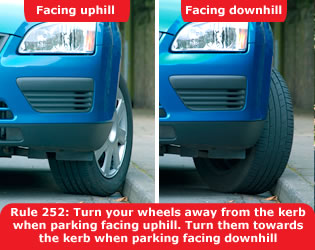 Go to main content
Go to main content
Archive Website of the UK government
Please note that this website has a UK government accesskeys system.
Main menu
Page menu
The Highway Code

Waiting and parking (238-252)
This Highway Code applies to England, Scotland and Wales. The Highway Code is essential reading for everyone.
238
You MUST NOT wait or park on yellow lines during the times of operation shown on nearby time plates (or zone entry signs if in a Controlled Parking Zone) – see 'Information signs' and 'Road markings'. Double yellow lines indicate a prohibition of waiting at any time even if there are no upright signs. You MUST NOT wait or park, or stop to set down and pick up passengers, on school entrance markings (see 'Road markings') when upright signs indicate a prohibition of stopping.
[Law RTRA sects 5 & 8]
Parking
239
Use off-street parking areas, or bays marked out with white lines on the road as parking places, wherever possible.
If you have to stop on the roadside:
- do not park facing against the traffic flow
- stop as close as you can to the side
- do not stop too close to a vehicle displaying a Blue Badge – remember, the occupant may need more room to get in or out
- you MUST switch off the engine, headlights and fog lights
- you MUST apply the handbrake before leaving the vehicle
- you MUST ensure you do not hit anyone when you open your door – check for cyclists or other traffic
- it is safer for your passengers (especially children) to get out of the vehicle on the side next to the kerb
- put all valuables out of sight and make sure your vehicle is secure
- lock your vehicle
[Laws CUR reg 98, 105 & 107, RVLR reg 27 & RTA 1988 sect 42]

240
You MUST NOT stop or park on:
- the carriageway or the hard shoulder of a motorway except in an emergency (see Rule 270)
- a pedestrian crossing, including the area marked by the zig-zag lines (see Rule 191)
- a clearway (see 'Traffic signs')
- taxi bays as indicated by upright signs and markings
- an urban clearway within its hours of operation, even when a broken white line is on your side of the road, except to pick up or set down passengers (see 'Traffic signs')
- a road marked with double white lines, except to pick up or set down passengers
- a tram or cycle lane during its period of operation
- a cycle track
- red lines, in the case of specially designated ‘red routes’, unless otherwise indicated by signs
Any vehicle may enter a bus lane to stop, load or unload where this is not prohibited (see Rule 141).
[Laws MT(E&W)R regs 7 & 9, MT(S)R regs 6 & 8, ZPPPCRGD regs 18 & 20, RTRA sects 5, 6 & 8, TSRGD regs 10, 26 & 27, RTA 1988 sects 21(1) & 36]
241
You MUST NOT park in parking spaces reserved for specific users, such as Blue Badge holders, residents or motorcycles, unless entitled to do so.
[Laws CSDPA sect 21 & RTRA sects 5 & 8]
242
You MUST NOT leave your vehicle or trailer in a dangerous position or where it causes any unnecessary obstruction of the road.
[Laws RTA 1988, sect 22 & CUR reg 103]
243
DO NOT stop or park
- near a school entrance
- anywhere you would prevent access for Emergency Services
- at or near a bus or tram stop or taxi rank
- on the approach to a level crossing or tramway crossing
- opposite or within 10 metres (32 feet) of a junction, except in an authorised parking space
- near the brow of a hill or hump bridge
- opposite a traffic island or (if this would cause an obstruction) another parked vehicle
- where you would force other traffic to enter a tram lane
- where the kerb has been lowered to help wheelchair users and powered mobility vehicles
- in front of an entrance to a property
- on a bend
- where you would obstruct cyclists’ use of cycle facilities
except when forced to do so by stationary traffic.
244
You MUST NOT park partially or wholly on the pavement in London, and should not do so elsewhere unless signs permit it. Parking on the pavement can obstruct and seriously inconvenience pedestrians, people in wheelchairs or with visual impairments and people with prams or pushchairs.
[Law GL(GP)A sect 15]
245
Controlled Parking Zones. The zone entry signs indicate the times when the waiting restrictions within the zone are in force. Parking may be allowed in some places at other times. Otherwise parking will be within separately signed and marked bays.
246
Goods vehicles. Vehicles with a maximum laden weight of over 7.5 tonnes (including any trailer) MUST NOT be parked on a verge, pavement or any land situated between carriageways, without police permission. The only exception is when parking is essential for loading and unloading, in which case the vehicle MUST NOT be left unattended.
[Law RTA 1988 sect 19]
247
Loading and unloading. Do not load or unload where there are yellow markings on the kerb and upright signs advise restrictions are in place (see 'Road markings'). This may be permitted where parking is otherwise restricted. On red routes, specially marked and signed bays indicate where and when loading and unloading is permitted.
[Law RTRA sects 5 & 8]
Parking at night
248
You MUST NOT park on a road at night facing against the direction of the traffic flow unless in a recognised parking space.
[Laws CUR reg 101 & RVLR reg 24]
249
All vehicles MUST display parking lights when parked on a road or a lay-by on a road with a speed limit greater than 30 mph (48 km/h).
[Law RVLR reg 24]
250
Cars, goods vehicles not exceeding 1525 kg unladen weight, invalid carriages, motorcycles and pedal cycles may be parked without lights on a road (or lay-by) with a speed limit of 30 mph (48 km/h) or less if they are
- at least 10 metres (32 feet) away from any junction, close to the kerb and facing in the direction of the traffic flow
- in a recognised parking place or lay-by
Other vehicles and trailers, and all vehicles with projecting loads, MUST NOT be left on a road at night without lights.
[Laws RVLR reg 24 & CUR reg 82(7)]
251
Parking in fog. It is especially dangerous to park on the road in fog. If it is unavoidable, leave your parking lights or sidelights on.
252
Parking on hills. If you park on a hill you should
- park close to the kerb and apply the handbrake firmly
- select a forward gear and turn your steering wheel away from the kerb when facing uphill
- select reverse gear and turn your steering wheel towards the kerb when facing downhill
- use ‘park’ if your car has an automatic gearbox

Decriminalised Parking Enforcement (DPE)
DPE is becoming increasingly common as more authorities take on this role. The local traffic authority assumes responsibility for enforcing many parking contraventions in place of the police. Further details on DPE may be found at the following websites:
Previous page / next page
Additional links
Simpler, Clearer, Faster

From 17 October, GOV.UK will be the best place to find government services and information
Help with PDF files
To view PDF files you need Adobe Reader. The program is freely available if you do not already have it.
 Facebook
Facebook Twitter
Twitter StumbleUpon
StumbleUpon Delicious
Delicious Reddit
Reddit